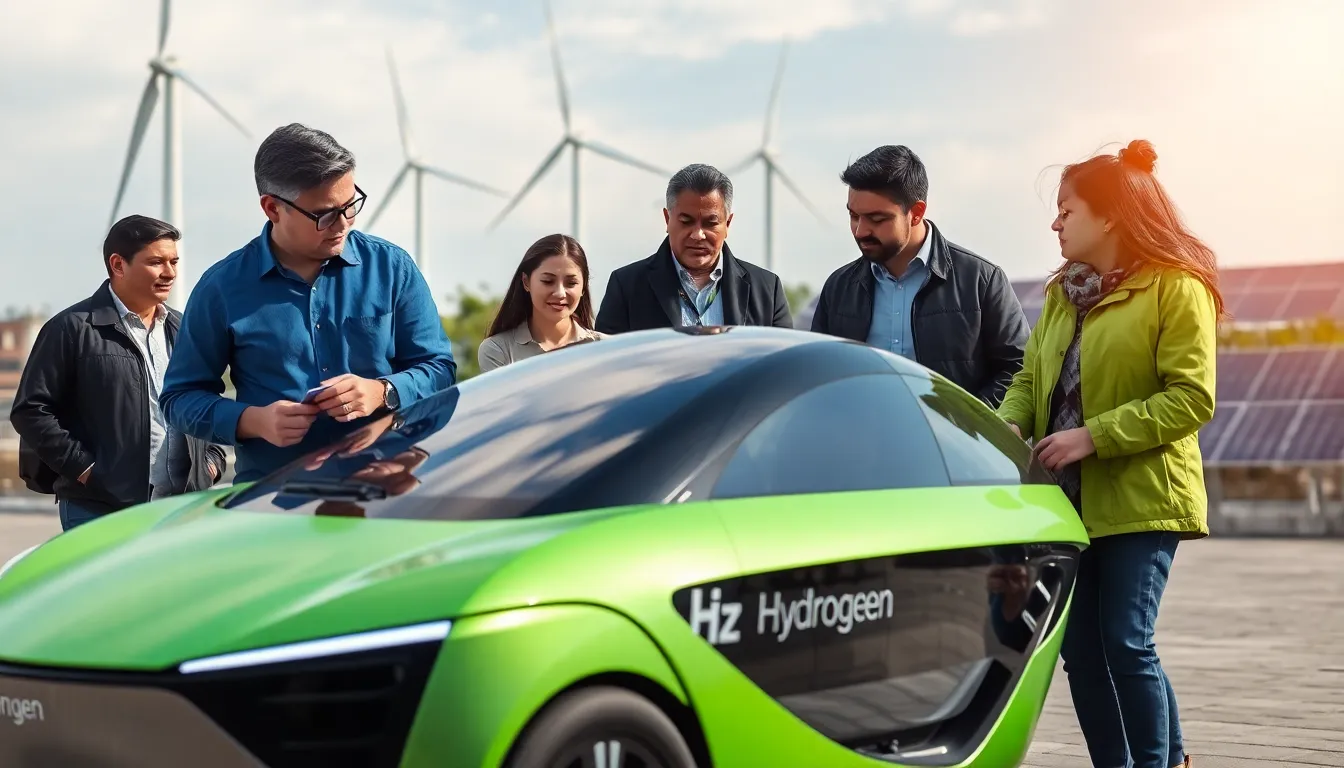As the world grapples with climate change, green hydrogen emerges as a beacon of hope in the quest for sustainable energy. Produced using renewable sources like wind and solar power, this clean fuel offers an innovative solution to reduce carbon emissions and transition away from fossil fuels. Its versatility makes it a prime candidate for various applications, from powering vehicles to heating homes.
In recent years, interest in green hydrogen has surged, driven by advancements in technology and growing investments. Countries and companies alike are racing to harness its potential, aiming to create a more sustainable energy landscape. Understanding green hydrogen’s role in the future of energy is crucial as it promises not only to reshape industries but also to contribute significantly to a cleaner planet.
Table of Contents
ToggleOverview of Green Hydrogen
Green hydrogen represents a pivotal advancement in energy technology. Generated through the electrolysis of water, it utilizes renewable energy sources like wind and solar power, ensuring zero carbon emissions during production. Green hydrogen stands in contrast to gray hydrogen, which relies on fossil fuels, primarily natural gas, and emits significant CO2 during its generation.
Green hydrogen serves several applications across various sectors. In transportation, it fuels hydrogen vehicles, offering an alternative to gasoline and diesel. In industrial processes, green hydrogen acts as a clean feedstock for chemical production and reduces emissions in steel manufacturing. Furthermore, it plays a role in energy storage, allowing excess renewable energy to be stored and utilized during low production periods.
Investment in green hydrogen projects continues to rise. According to the International Energy Agency (IEA), global investment in hydrogen technologies reached approximately $1.5 billion in 2020, with projections of significant growth in the coming years. Countries like Germany and Japan are leading initiatives to develop hydrogen infrastructure, further signifying its importance in future energy transitions.
Challenges remain for widespread adoption. Key issues include high production costs, the need for robust infrastructure, and the requirement for advancements in electrolysis technology. However, ongoing research and development efforts focus on making green hydrogen more accessible and economically viable, facilitating its integral role in a sustainable global energy framework.
Production Methods

Green hydrogen production utilizes various methods, with the primary techniques being electrolysis and biomass gasification. Each method presents unique advantages and challenges in the context of sustainability and efficiency.
Electrolysis Process
Electrolysis involves using electricity to split water into oxygen and hydrogen. Renewable energy sources, such as wind or solar, provide the electricity, ensuring no carbon emissions. Current electrolysis technologies include:
- Alkaline Electrolysis: Uses alkaline solutions; it’s cost-effective and has a long track record.
- Proton Exchange Membrane (PEM) Electrolysis: Employs a solid polymer electrolyte; offers high efficiency and rapid response times.
- Solid Oxide Electrolysis: Operates at high temperatures; less energy-intensive but currently at a developmental stage.
Each method aims to increase efficiency and lower costs, driving further investment in green hydrogen infrastructure.
Biomass Gasification
Biomass gasification converts organic materials into hydrogen via high-temperature processes. This method involves several key steps:
- Feedstock Selection: Utilizes materials like agricultural waste or wood chips, creating a renewable input source.
- Gasification Process: Applies heat and limited oxygen to produce syngas, a mix of hydrogen and carbon monoxide.
- Hydrogen Extraction: Separates hydrogen from syngas, often using additional processes to purify the fuel.
Biomass gasification contributes to circular economy principles, recycling waste into usable energy while maintaining lower carbon emissions compared to fossil fuels.
Applications of Green Hydrogen
Green hydrogen demonstrates significant versatility across various sectors, particularly in transportation and industry. Its applications can substantially enhance sustainability efforts and help mitigate climate change.
Transportation Sector
Green hydrogen plays a pivotal role in the transportation sector by powering fuel cell electric vehicles (FCEVs). FCEVs emit only water vapor, providing a clean alternative to conventional gasoline or diesel vehicles. Several manufacturers, including Toyota and Hyundai, have developed FCEVs, which offer refueling times comparable to traditional vehicles.
Moreover, green hydrogen supports various transportation modes, such as buses, trains, and trucks. Hydrogen-powered buses are already operational in cities across Europe, reducing urban air pollution. Ultimately, investment in hydrogen infrastructure, including refueling stations, enables broader adoption of hydrogen technologies in transportation.
Industrial Use
Green hydrogen serves as a clean feedstock in multiple industrial processes. It replaces fossil fuels in high-temperature applications, such as steel production, significantly reducing carbon emissions. Major steel companies, including ArcelorMittal and Thyssenkrupp, are exploring hydrogen’s potential in their operations.
Additionally, green hydrogen contributes to ammonia production, a vital component in fertilizers. The Haber-Bosch process, which traditionally relies on natural gas, can utilize green hydrogen to create ammonia without carbon emissions. This shift not only benefits agriculture but also aligns the industry with sustainability goals, ensuring a cleaner production pathway.
Advantages of Green Hydrogen
Green hydrogen presents numerous advantages, particularly in environmental and economic aspects. Its potential to support sustainable energy solutions makes it a valuable resource in the global transition toward a low-carbon future.
Environmental Benefits
Green hydrogen significantly reduces carbon emissions by utilizing renewable energy sources, such as wind and solar, for production. Unlike gray hydrogen, which releases CO2 through fossil fuel consumption, green hydrogen’s electrolysis process produces purely water vapor as a byproduct. This characteristic aligns with global efforts to mitigate climate change by lowering greenhouse gas emissions. Furthermore, green hydrogen promotes resource circularity by facilitating biomass gasification, which recycles organic waste into energy. Its adoption can lead to cleaner air quality and reduced reliance on fossil fuels, making it crucial for environmental sustainability.
Economic Potential
The economic potential of green hydrogen is substantial, driven by its versatility across various sectors. Investments surged significantly, with global financing exceeding $1.5 billion in 2020, underscoring industry confidence in future growth. Green hydrogen can create new job opportunities in manufacturing, installation, and maintenance of renewable energy systems and hydrogen infrastructure. It presents cost-effective solutions in high-temperature industrial processes, which can lower production costs for sectors like steel and ammonia. Additionally, as technology advances and economies of scale are achieved, the production costs of green hydrogen are expected to decline, enhancing its competitiveness against traditional energy sources.
Challenges and Limitations
Green hydrogen faces several challenges and limitations that hinder its widespread adoption. Key issues include the need for advanced infrastructure and cost factors associated with production and distribution.
Infrastructure Requirements
Robust infrastructure is essential for the successful deployment of green hydrogen. The current hydrogen infrastructure remains limited, making it challenging to facilitate production, storage, and distribution. Investments in refueling stations, pipelines, and storage facilities are crucial. Without a comprehensive network, green hydrogen cannot effectively support transportation and industrial applications. Various countries, such as Germany and Japan, are making strides in infrastructure development, but significant gaps remain in many regions worldwide.
Cost Factors
Cost factors play a significant role in green hydrogen’s market viability. Production through electrolysis currently presents high expenses, largely due to electricity costs and the price of electrolyzer technologies. Research indicates that production costs for green hydrogen range from $3 to $6 per kilogram, considerably higher than fossil fuel alternatives. Economies of scale can help reduce these prices, yet substantial initial investments are needed to realize long-term cost reductions. Ongoing technological advancements aim to enhance efficiency and lower production costs, but achieving parity with traditional energy sources remains a significant challenge in promoting widespread adoption.
Green hydrogen stands at the forefront of the transition to sustainable energy. Its ability to significantly reduce carbon emissions while providing versatile applications makes it a game changer in various sectors. As investments grow and technology advances, the path to broader adoption becomes clearer.
Addressing the challenges of production costs and infrastructure development will be crucial for its success. With key players like Germany and Japan leading the way, the global commitment to green hydrogen is expected to strengthen. This clean energy source not only aligns with climate goals but also paves the way for economic growth and job creation. Embracing green hydrogen could redefine the future of energy, fostering a cleaner and more sustainable world.

